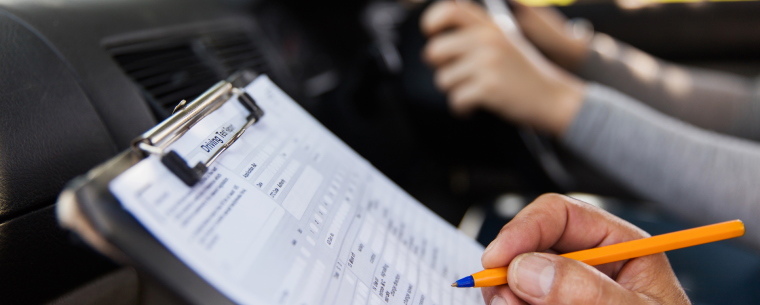Passed Your Test? Here Are 5 Things You Need to Know
Jack Dreyer | Wednesday 24th August 2022 12:30pm

Being new on the roads can be daunting. The process of learning to drive isnít always an easy one - understandably so - and while it does provide a comprehensive baseline for being safe behind the wheel, it canít prepare you for all of the experiences youíll likely encounter.
Fear of these unknowns can very quickly build up, causing you to feel stressed or anxious at the potential of them happening - or rather, waiting for them to happen.
In our recent survey of 2000 UK adults, we found many common threads when it came to the most stressful experiences for new drivers. In this article, weíre going to look at some of the results - and break down how you can ensure they never cause you undue panic again.
How to change a tyre
In our survey, we found that 65% of people found getting a flat tyre to be a stressful experience - with almost ? of respondents experiencing it within the first 6 months of passing their test. When youíre new to driving it can be hard to know what to do in this situation, but there are a few simple things to keep in mind.
Firstly, ensure youíre able to stop your car in a safe spot, visible to other drivers but out of the way of traffic. If you have a spare tyre and the correct tools - including a jack, wrench, and locking wheel nut key - then you can attempt to change the tyre yourself.
Take a look at our guide to changing a car tyre for a step-by-step breakdown, but keep in mind that you should never attempt this if you feel that the environment around you is unsafe. In that instance, move away from the road and contact a breakdown service.
What to do when you break down

Breaking down is a very stressful experience as a driver - particularly when youíre new to getting behind the wheel. In fact, it topped the list of most stressful driving experiences in our survey, with 74% finding it stressful - and 33% finding it extremely stressful.
While it is a stressful situation to find yourself in, know that in some instances it simply canít be helped. The first thing to do is move your car to a safe space, turning off at the next junction where possible if youíre on a motorway or busy road.
Once youíre in a safe spot, put your hazards on, get out of the car, and move away from the road - use the passenger side if youíre on the motorway. Remember that itís dangerous to stay in your car when you break down.
When youíre safely away from the dangers of nearby traffic, call for assistance. If you break down on a motorway, there are some additional considerations - check out our guide for full details.
Donít forget that regular car maintenance can help to prevent car breakdowns, so getting in a good routine of annual car servicing is always a good idea.
What to do if a warning light appears
For new drivers, a warning light appearing on the dashboard was one of the top stressful experiences to encounter - with 19% of those surveyed describing the experience as extremely stressful. In fact, we found that a warning light causes a fairly consistent level of stress irrespective of experience, meaning even if youíve been on the road for a while, it may still make you tense.
The key thing to remember is that, in many cases, you can continue driving - until you can get your car to a garage for a diagnostic check. Itís important to familiarise yourself with the warning light meanings for your specific model of car, which can often be found in your ownerís manual, or online.

One of the most concerning warning lights is the brake warning light, which often looks like a circle around an exclamation mark, surrounded on each side by what look like rounded brackets. Weíve got a comprehensive guide for what to do if your brake warning light comes on, as well as one specifically for your oil warning light coming on, too. However, if a light does appear, itís best to book an appointment with a trained technician as soon as possible to ensure your car stays safe.
What to know when taking your car for an MOT
Taking your car for its first MOT can be quite daunting. In fact, 34% of respondents in our survey reported finding the experience stressful.
It makes sense ó thereís the possibility that there will be something wrong with your vehicle that youíll have to pay to fix. But, with a reliable mechanic, you can rest assured that your car is in safe hands and, if work is needed, youíll have the process and any issues explained to you.
Itís best to also keep in mind that an MOT isnít just a yearly cost ó itís a legality that keeps you safe, as well as saving you money on repairs in the long run.
When taking your car for its first MOT, be sure to prepare by ticking off our pre-mot checklist. There are plenty of things you can check at home before going so that you donít fail on something simple like a lack of windscreen washer fluid.
Not sure when your MOT is due? Use our free MOT date checker tool before booking in with the experts.
How to jump start your car

Sometimes, often at the most inconvenient moment, your car battery will fail you. It might be a winter morning before you head off to work; you try to start the engine and you just get a clicking sound in return.
When this happens, youíll need to either use a battery charging bank or enlist the help of another vehicle with a running battery. It helps to always have jump leads stowed in the back of your car so that you can get going in a pinch!
Now, the process of jump starting your car is not complicated, but itís vital to get it right for safety reasons. Read our guide to jump starting a car with a dead battery.
If your carís battery dies again soon after, itís best to book in for a battery health check.
Safe car, safer driving
One thing to remember as a new driver is that a lot of unfortunate or stressful incidents can be avoided, or at least minimised, through a proactive car maintenance routine. Ensure you take your car for regular servicing and scheduled MOT appointments, but, if you have any concerns or warning lights appear, book an ad hoc appointment at your local centre as soon as possible.
Any facts, figures and prices shown in our blog articles are correct at time of publication.
Featured Articles
Is it Illegal to Drive With One Headlight?
Saturday 19th July 2025
Wondering if itís illegal to drive with one headlight? Learn about the safety risks and penalties of illegal blown bulbs and why you should fix them promptly.
Air Con in EVs & Hybrids: Experts Answer Your Questions
Monday 30th June 2025
Does air con drain EV batteries? Can you use the air con while charging an electric car? Find out the answers to these questions & more from Kwik Fitís experts.
Why Is Your Car Making a Noise? Fixes & Tips
Friday 13th June 2025
When your car starts making unexpected noises, it can certainly be quite disconcerting; it may be nothing to worry about, but hereís what you need to know.









